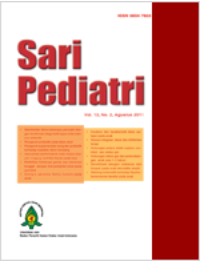Insidens dan Karakteristik Klinis Epilepsi pada Anak
Sari
Latar belakang.Epilepsi merupakan salah satu penyebab terbanyak morbiditas di bidang saraf anak, yang
berdampak terhadap tumbuh-kembang anak. Epilepsi merupakan diagnosis klinis, insidensnya bervariasi di
berbagai negara. Elektroensefalografi (EEG) dikerjakan untuk melihat fokus epileptogenik, sindrom epilepsi
tertentu, evaluasi pengobatan, dan menentukan prognosis. Pencitraan dilakukan untuk mengetahui adanya
fokus epilepsi dan kelainan struktur otak lainnya.
Tujuan. Mengetahui insidens dan karakteristik klinis, gambaran EEG dan pencitraan pasien epilepsi di
bagian/SMF Ilmu Kesehatan Anak FK UNUD/ RSUP sanglah Denpasar Bali, selama periode Januari
2007- Desember 2010.
Metode.Penelitian potong lintang dengan observasi langsung. Data diambil dari setiap pasien yang baru
dengan diagnosis epilepsi di Poliklinik Anak dan ruang rawat inap Bagian/SMF Ilmu Kesehatan Anak FK
UNUD/RSUP Sanglah Denpasar selama Januari 2007-Desember 2010. Data yang dikumpulkan adalah
umur, jenis kelamin, status gizi, gambaran klinis epilepsi, penyakit neurologis penyerta, status tumbuh
kembang, riwayat kejang demam, riwayat epilepsi keluarga, gambaran EEG dan pencitraan kepala.
Hasil. Ditemukan 276 kasus epilepsi, dengan insidens 5,3%. Sebagian besar laki-laki (56,9%), terbanyak
(42%) umur 1–5 tahun dan onset tersering umur <1 tahun (46%) kasus. Diagnosis epilepsi umum tonikklonik (62%), dan sindrom epilepsi yang ditemukan spasme infantil 6,9% kasus. Sebagian besar tumbuh
kembang normal (75%), riwayat kejang demam sebelumnya 10,1% kasus dan riwayat epilepsi keluarga 13%
kasus. Pemeriksaan EEG pertama ditemukan abnormal 42,4% kasus dan pada CT scankepala ditemukan
kelainan pada 51,4 % kasus.
Kesimpulan.Ditemukan 276 kasus epilepsi, dengan insidens 5,3%, terutama terjadi pada anak laki-laki
(56,9%). Sebagian besar (62%) epilepsi umum tonik-klonik. Gambaran EEG pertama kali abnormal pada
42,4% kasus. Pada CT scankepala, ditemukan kelainan pada 51,4 % kasus.
Kata Kunci
Teks Lengkap:
PDFReferensi
Major P, Thiele EA. Seizure in children: laboratory,
diagnosis, and management. Pediatr Rev 2007;28:405-14.
Aydin A, Ergor A, Ergor G, Dirik E. The prevalence
of epilepsy amongst school children in Izmir, Turkey.
Seizure 2002;11:392-6.
Harsono, Endang K, Suryani G. Pedoman tata laksana
epilepsi. Edisi Ke-3. Perdossi. 2006;62:1-43
Johnston MV. Seizure in childhood. Dalam: Behrman
RE, Kliegman RM, Jenson HB, penyunting. Nelson
textbook of pediatrics. Edisi Ke-17. Philadelphia;
Saunder;2004.h.1993-2005.
Mohammed MS. Assessment of the utility of paediatric
electroencephalography. Seizure 2002;11:99-103.
Doescher JS, de Grauw TJ, Musick BS, Dunn DW,
Kalnin AJ, Egelhoff JC, dkk. Magnetic resonance
imaging (MRI) and electroencephalography(EEG)
findings in a cohort of normal children with newly
diagnosed seizure. J. Child Neurol 2006;21: 490-5.
Ali C, Ayse S, Deniz Y, Vehbi D, Secil O, Tugbna H,
dkk. Prevalence of some risk factors in childhood with
epilepsy compared to their controls. Seizure 2007;16:
-44.
Fosgren L. Epidemiology of epilepsy : a global problem.
Program and abstract of the 17
th
World Congress of
Neurology. J Neurol Sci 2001;187(Suppl.I):S212.
Reading R, Haynes R, Beach R. Deprivation and incidence
of epilepsy in childhood. Seizure 2006;15:190-3.
Christensen J, Vestergaard M, Mortensen PB, Sidenius
P, Agerbo E. Epilepsy and risk of suicide: a population
based case control study. Lancet Neurol 2007;6:693-8.
Khreisat WH. Clinical profile of epilepsy during the two
years of life. Pak J Med Sci 2006;22:55-9.
Sidenvall R, Forsgrent L, Heijbel J. Prevalence and
characteristics of epilepsy in children in Northern
Sweden. Eur J Epilepsy 1996; 5: 139-46.
Schiariti V, Farrell K, Hoube JS, Lisumkovas. Period
prevalence of epilepsy in children in BC: a populationbase study. Can J Neurol Sci 2009;36:36-41.
Mohammed MS. Clinical review of pediatric epilepsy.
Neuroscience 2005;10:255-64.
Preux PM, Cabanac MD. Epidemiology and aetiology of
epilepsy in sub-saharan Africa. Lancet Neurol 2005;4:21-31.
Cowan LD. The epidemiology of the epilepsies in
children. Ment Retard Dev Disabil Res Rev 2002;8:171-81.
Kaneko S, Okada M, Iwasa H, Yamakawa K, Hirose
S. Genetic of epilepsy: current status and perspective.
Neurosci Res 2002;44:11-30.
Sianturi P, Syarifuddin A, Bistok Saing. Incidence of
epilepsy among patients with cerebral palsy. Paediatr
Indones 2001;41:202-7.
Bruck I, Antoniuk SA, Spessatto A, deBem RS,
Huusberger R, Pacheco CG. Epilepsy in children with
cerebral palsy. Arq Neropsiquiatr 2001;59:35-9.
Peet DS. Retrospective review of the epidemiology of
epilepsy in special school for children with cerebral palsy,
learning difficulties. MJM 2006;9:19-23.
Guzeva VI, Belash VO, Guzeva VV, Guzeva OV,
Anstazi OIE. Characteristics of cognitive functions in
children with epilepsy. Neurosci and Behav Physiol2006;9:
-9.
Mohammed MS. Cerebral palsy: comprehensive review
and update. Ann Saudi Med 2006;26:123-32.
Kurukawa T, Yokomizo Y, Lee S, Kusuda T. Clinical
featurs of epilepsy with pervasive developmental
disorders. Brain Dev 2010;32:764-8.
Jaseja H. Sygnificance of the EEG in the decision to
initiate antiepileptic treatment in patients withs epilepsy:
a perspective on recent evidence. Epilepsy&Behavior
;16:245-6.
Doose H. Genetic EEG traits in the pathogenesis of the
epilepsies, a review article. J.Epilepsy 1997;10:97-110.
Noachtar S, Remi J. The role of EEG in epilepsy: A
critical review. Epilepsy Behav 2009;13:22-33.
Deroos ST, Chillag KL, Keeler M, Gilbert DL. Effect of
sleep devrivation on the pediatric electroencephalogram.
Pediatrics 2009;123:703-8.
Shinnar S, Berg AT, Moshe SL, O Dell C, Alemany M,
Newstein D, dkk. The risk of seizure recurrence after
a first unprovoked a febrile seizure in childhood: an
extended follow-up. Pediatrics 1996;98:216-25.
Wright NB. Imaging in epilepsy: a paediatric perspective.
Br J Radiol 2001;74:575-89.
Gaillar WD, Chiron C, Cross JH, Harvey S, Kuzniecky
R, dkk. Guidelines for imaging infants and children with
recent-onset epilepsy. Epilepsia 2009;50:2147-53.
Major P, Thiele EA. Seizure in children: determining the
variation. Pediatr Rev 2007;28:363-71.
Jain R, Mishra D, Junena M. Add-on lamotrigin in
pediatric epilepsy in India. Indian Pediatrics 2010;
:1-4.
DOI: http://dx.doi.org/10.14238/sp13.2.2011.123-8
Refbacks
- Saat ini tidak ada refbacks.
##submission.copyrightStatement##
##submission.license.cc.by-nc-sa4.footer##
Email: editorial [at] saripediatri.org


Sari Pediatri diterbitkan oleh Badan Penerbit Ikatan Dokter Anak Indonesia
Ciptaan disebarluaskan di bawah Lisensi Creative Commons Atribusi-NonKomersial-BerbagiSerupa 4.0 Internasional.





